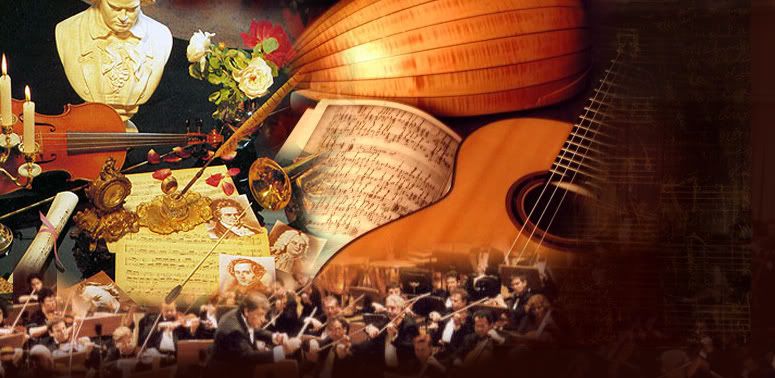The G Clef
Thursday, December 29, 2005
Indian National AnthemLanguage : Bengali
Song : Jana Gana Mana
Album : Indian National Anthem
Defaults : s r2 g3 m1 p d2 n3 (C D E F G A B)
Jana-gana-mana-adhinayaka, jaya he
s r g g g g gg g g g r g m
Bharata-bhagya-vidhata
g g g r r r nr s
.
Punjab-Sindhu-Gujarata-Maraatha-
s p p p p p m2p p p m2dp
Dravida-Utkala-Banga
m m m g g m r mg
Vindhya-Himachala-Yamuna-Ganga
g g g g g r p p p m m
Uchchala-Jaladhi-taranga
g g g r r r r nr s
.
Tava shubha name jage
s r g g g g rgm
Tava shubha ashish maange
g m p p p m g r m g
Gahe tava jaya-gatha
g g r r r r nrs
.
Jana-gana-mangala-dayaka jaya he
p p p p p p m2 p p p m2d p
Bharata-bhagya-vidhata
m m m g g m rm g
Jaya he, jaya he, jaya he
S n S n d n d p d
Jaya jaya jaya, jaya he
s s r r g g r g m 1
Thanks to VK's Notes.
Tags: Music classical music
Tuesday, December 20, 2005
Classical Guitar FeaturesJust now I found this wonderful information on Classical Guitar features on net.
The classical guitar is distinguished by a number of features:
* It is an acoustic instrument. The sound is amplified by a sound box.
* It has six strings. A few classical guitars have eight or more strings to expand the bass scale, even out overtone production, and allow lute music written for lutes with more than six courses of strings to be played.
* The strings are made from nylon (formerly catgut, which is made from sheep intestine, despite the name), as opposed to the metal strings found in some other forms of guitar. These strings have a much lower tension than steel strings. The lower three strings ('bass strings') are wound with metal, commonly silver or nickel. Some less common stringings use a fourth wound string.
* Because of the low tension of the strings the neck can be made entirely of wood, not requiring a steel truss rod.
* Also because of the low tension of the strings, the interior bracing of the sound board can be lighter, which allows more complex tonal qualities.
* The neck tends to be broader than with steel string guitars, making more complex fingerwork easier, but which may require a more exacting left hand position.
* The strings are usually plucked with the fingers. Most players shape their fingernails so that they contact the string in a certain way to achieve the desired tone.
* Traditionally, the tuning pegs (or "keys") at the head the fingerboard of a classical guitar point backwards (towards the player when the guitar is in playing position; perpendicular to the plane of the fretboard). This is in contrast to a traditional steel-string guitar design, in which the tuning pegs point outward (up and down from playing position; parallel to the plane of the fretboard).
* Classical guitars are typically built without pick-guards. A pick-guard is a piece of plastic affixed just below the strings on steel-string guitars to protect the sound board of the guitar from damage by aggressive strumming with a pick. It is assumed that a classical guitar will be played only with the fingers, and that a pick-guard is unnecessary.On flamenco guitars a tapping, or golpe board is attached to the front of the guitar, below the sound hole to allow the use of techniques that would normally damage a classical guitar.
Classical guitars are normally played without amplification of any sort but they can be equipped with an electronic pickup, which is sometimes used by performers in noisy environments. Either a piezoelectric pickup is placed under the bridge, or a microphone is suspended within the body.
Monday, December 05, 2005
What is a Recorder?
We all know the word "Recorder" in different context. However, we are now going to talk about a musical instrument called, Recorder.
What is a Recorder?
Recorders are "fipple flutes", like whistles. Today most people's idea of a recorder is a small, plastic, squeaky thing played by fourth grade students, but in the hands of a skilled player, even the highest-pitched recorder is a sweet-toned instrument that rivals the silver flute in all but range and volume. The modern recorder is a style introduced during the Baroque period. Renaissance recorders are less common, having a wider bore, and have a sweeter tone. Medieval recorders had a straight bore (as opposed to later recorders, which are widest near the fipple (whistle part) and narrowest at the foot (part furthest from the player), a softer sound, and much less range.
There are several sizes of recorder, ranging from "garklein" through "extended great bass". The size played by schoolchildren is usually the soprano, which has middle C as its lowest note. Above the soprano is the sopranino, which starts on F; and the garkelein, which starts an octave above middle C. Below the soprano is the alto, which starts on F an octave below the sopranino; the tenor, which starts an octave below middle C; the bass, which starts an octave below the alto; the great bass, an octave blow the tenor; and the extended great bass, an octave below the bass. While each recorder has a range of only two octaves (though I've seen references to skilled players being able to play part of a third octave), the recorder family as a whole spans pretty much the entire range of notes you'd want to hear. The most common sizes are sopranino, soprano, alto, tenor, and bass.
A recorder has seven holes on the front (three for the left hand and four for the right) and a thumbhole on the back (left hand). Most have double holes for the bottom two holes, and larger recorders have keys for the harder to reach holes.
History of Recorder:
The recorder is the most highly developed member of the ancient family of internal duct flutes or fipple flutes with a fixed wind-way formed by a wooden plug or block. It is unique from other internal duct flutes by having holes for seven fingers and a single hole for the thumb, which also serves as an octaving vent.
The earliest unambiguous illustration of a recorder is that, in which a musician plays a cylindrical duct-flute, the window / labium of which is clearly visible, and at the foot of which there is an open finger hole for the little finger of the lowermost hand.
Earlier to this, there are a number of illustrations of ambiguous 'pipes', which may (or may not) be duct-flutes, which may (or may not) be recorders. Amongst the earliest is Solome's Dance, also known as the Bernward Column, a bronze cast from Hildesheim Cathedral (Germany) in which Salome dances to the accompaniment of a straight cylindrical pipe, which has four holes visible, the lowest slightly offset. It is clasped between two hands, just above which there is a notch (window); the mouthpiece is beak-shaped, and the player (a man) does not have the puffed cheeks characteristic of shawm players.
History of Recorder crossed many types of recorder in different ages.
The recorder achieved great popularity in the 16th and 17th centuries. For example, at Henry VIII's death in 1547, an inventory of his possessions included 78 recorders. There are also numerous references to the instrument in contemporary literature (e.g. Shakespeare, Pepys and Milton). Several changes in the construction of recorders took place in the seventeenth century, resulting in the type of instrument generally referred to as baroque recorders, as opposed to the earlier renaissance recorders. These innovations allowed baroque recorders to play two full chromatic octaves of notes, and to possess a tone, which was regarded as "sweeter" than that of the earlier instruments.
Nowadays, designers of factory-made instruments for amateur and school use continue to produce recorders with a somewhat blander, flute-like tone than the eighteenth-century originals on which they are based. Nonetheless, these neo-baroque recorders remain essentially solo instruments and are inherently unsuited to being played together in consorts. As we shall see, such instruments demand a very sophisticated technique indeed, if tone and tuning are to be acceptable to any but uncritical listeners. Played together by children or adult amateurs they generally sound harsh and discordant. The style of recorder most appropriate for use by children and amateurs is surely the renaissance instrument designed specifically for blending with each other. Although reconstructions of such recorders are available, their cost puts them well out of the reach of all but specialist players.
How to use Recorder:

Playing Recorder is very simple. All you need to know is Music theory, which is basic in music, and the fingering to use. As a family of wind instruments, you need to know the breathing technique where you can control your breath in long run of music.
Recorder comes in the family of Woodwind instrument of music. Anyone can blow air into an instrument - the skill is to make notes with those magic fingers. This instrument has difference sizes, mainly made up of Wood or plastic. Plastic records mostly come in two colors black or cream.
The recorder is a very social instrument. Many amateurs prefer to play in large groups or in one-to-a-part chamber groups, and there is a wide variety of music for such groupings including many modern works. Groups of different sized instruments help to compensate for the limited note range.
Present Day Status:
One of the most interesting developments over the last 30 years has been the development of recorder orchestras. They can have up to 60+ players and use up to 8 or 9 sizes of instruments. In addition to arrangements, a lot of new music, including symphonies, has been written. There are recorder orchestras in Germany, Holland, Japan, The United States and in the UK which has about eight to nine Orchestras, including a National Youth Recorder Orchestra.
Friday, December 02, 2005
European Classical Music Period and timeThe European Classical Music period is divided into 6. Below you can find all 6 periods with detail.
Medieval: generally before 1450. Chant, also called plainsong or Gregorian Chant, was the dominant form until about 1100.
Renaissance: about 1450–1600, characterized by greater use of instrumentation and multiple melodic lines
Baroque: about 1600–1750, characterized by the use of counterpoint and growing popularity of keyboard music and orchestral music
Classical: about 1730–1820, an important era which established many of the norms of composition, presentation and style.
Romantic: 1815–1910 a period which codified practice, expanded the role of music in cultural life and created institutions for the teaching, performance and preservation of works of music.
Modern: 1905–1975 a period which represented a crisis in the values of classical music and its role within intellectual life, and the extension of theory and technique. Some theorists, such as Arnold Schoenberg in his essay "Brahms the Progressive," insist that Modernism represents a logical progression from 19th century trends in composition; others hold the opposing point of view, that Modernism represents the rejection or negation of the method of Classical composition.
20th century: usually used to describe the wide variety of post-Romantic styles composed through 2000, which includes late Romantic, Modern and Post-Modern styles of composition.















